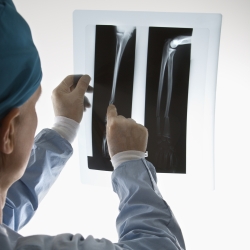 World health has traditionally been the remit of epidemiologists and infectious disease specialists. The global morbidity and mortality rates associated with infections such as HIV1 and malaria2 are undisputedly high, and the organisations and strategies to combat them reflect this1,2,3. Yet the burden of orthopaedic diseases is comparable to that of communicable diseases4, although there is a marked scarcity of similarly comprehensive international efforts to reduce their impact.
World health has traditionally been the remit of epidemiologists and infectious disease specialists. The global morbidity and mortality rates associated with infections such as HIV1 and malaria2 are undisputedly high, and the organisations and strategies to combat them reflect this1,2,3. Yet the burden of orthopaedic diseases is comparable to that of communicable diseases4, although there is a marked scarcity of similarly comprehensive international efforts to reduce their impact.
The World Health Organisation quantifies burden of disease using disability adjusted life years5. Worldwide, injury accounts for 12% of all DALYs lost – a striking figure when compared to those for tuberculosis (2.5%), HIV (6%) and cancer (6%)6. There were an estimated 9 million osteoporotic fractures globally in the year 2000, projected to increase by 310% and 240% in men and women respectively by 20507.
Currently, osteoporotic fractures represent almost 1% of the global burden of non-infectious disease. Additionally, cases of other degenerative, infectious and congenital diseases of the bone remain major worldwide causes of morbidity and mortality5.
As such, the scope for orthopaedic surgeons to impact world health is enormous – although the method by which they do so must be carefully considered. The needs of a population vary greatly between countries: in the developing world traumatic injury is the main source of orthopaedic pathology8, whereas in the developed world conditions associated with ageing are more common9.
In China, South America and South Asia – home to the majority of the world’s inhabitants – the proportion of DALYs lost through injury is near to 20%5. This is partly due to the higher rates of accidents8,10, although it is also largely affected by the lack of adequate care – both orthopaedic and not11.
To improve orthopaedic outcomes in these regions, a combination of measures must be taken. Simply increasing clinical staff is not a viable or sustainable option. The most effective method of providing a long term solution is education: training local health care workers will provide a self-sustainable supply of orthopaedic clinicians12. Educational organisations are already implementing such progammes12,13,14, with special emphasis on involving trainees to encourage life-long international cooperation, or simply to offer opportunities for short term overseas work placements.
Importantly, working abroad can provide the orthopaedic trainee with invaluable clinical experience15, whilst simultaneously benefiting the orthopaedic patient. Of particular note is the Global Initiative for Emergency and Essential Surgical Care, a WHO programme aimed at supporting improved international partnerships, education schemes and enhanced provision of surgical care in poor regions14.
Finally, it is also prudent to consider the domestic situation. As our population continues to age, along with that of much of the western world, the field of orthopaedics will find itself subjected to for an ever-increasing demand for hip and knee arthroplasty16. Clearly, world health is no longer just the responsibility of the infectious disease specialist or indeed the epidemiologist. The orthopaedic surgeon can not only help the needy individual, but also have a positive impact upon wider society through education, international cooperation and improved provision of care throughout the world.
References
1. WORLD HEALTH ORGANISATION; 2011; Global Health Sector Strategy on HIV/AIDS 2011-15; World Health Organisation; Switzerland
2. WORLD HEALTH ORGANISATION; 2011; World Malaria Report 2011 World Health Organisation; Switzerland
3. WORLD HEALTH ORGANISATION; 2012; Infectious Diseases; Health Topics; available at http://www.who.int/topics/infectious_diseases/en/. Accessed 15/01/2012
4. BEVERIDGE, M; HOWARD, A; 2004; The Burden of Orthopaedic Disease in Developing Countries; Journal of Bone and Joint Surgery; 86-A:1819-1822
5. WORLD HEALTH ORGANISATION; 2003; The Burden of Orthopeadic Conditions at the Start of the New Millennium; WHO Technical Report Series; Switzerland
6. WORLD HEALTH ORGANISATION; 2002; Burden of disease in DALYs by cause, sex and mortality stratum in WHO regions, estimates for 2001; World health report 2002; Switzerland
7. GULLBERG, B; JOHNELL, O; KANIS, J; 1997; World-wide projections for hip fracture. Osteoporosis International; 7:407.
8. PEDEN, M; McGEE, K; KRUGER, E; 2002; Injury: A Leading Cause of the Global Burden of Disease; World Health Organisation; Switzerland
9. JOHNELL, O; KANIS, J; 2006; An Estimate of the Worldwide Prevalence and Disability Associated with Osteoporotic Fractures; Osteoporosis International; 17:1726–1733
10. PEDEN, M; et al; 2004; World Report on Road Traffic Injury Prevention; World Health Organisation; Switzerland
11. DORMANS, J. P; FISHER, R. C; PILL, S. G; 2001; Orthopaedics in the Developing World: Present and Future Concerns; Journal of the American Academy of Orthopaedic Surgeons; 9:289-296.
12. DORMANS, J. P; 2002; Orthopaedic Surgery in the Developing World-Can Orthopaedic Residents Help?; Journal of Bone and Joint Surgery; 84, 1086
13. DERKASH, R; KELLY, N; 2002; The History of Orthopaedics Overseas; Clinical Orthopaedics and Related Research; 396:30-5
14. WORLD HEALTH ORGANISATION; 2007; WHO Meeting on Global Initiative for Emergency and Essential Surgical Care (GIEESC); Health Technology and Pharmaceuticals Cluster; World Health Organization; Switzerland
15. ROVINSKY, D; COUGHLIN, R; 2008; Orthopaedic residents need experience abroad; American Association of Orthopaedic Surgeons Now; 6:1
16. CULLIFORD, D; MASKELL, J; BEARD, D; MURRAY, D; PRICE, A; ARDEN, N; 2010; Temporal Trends in Hip and Knee Replacement in the United Kingdom; Journal of Bone and Joint Surgery Britain; 92:130-135



